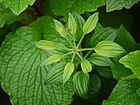Note: This is a project under development. The articles on this wiki are just being initiated and broadly incomplete. You can Help creating new pages.
Difference between revisions of "Rubia cordifolia - Manjishtha"
(→External Links) |
(→Photo Gallery) |
||
| Line 61: | Line 61: | ||
==Photo Gallery== | ==Photo Gallery== | ||
<gallery class="left" caption="" widths="140px" heights="140px"> | <gallery class="left" caption="" widths="140px" heights="140px"> | ||
| − | |||
| − | Mancitti (Tamil- மஞ்சிட்டி) (4846178555).jpg | + | Mancitti (Tamil- மஞ்சிட்டி) (4846178555).jpg|Leaves |
| − | Manjishta (Marathi- मंजिष्ठ) (6331765104).jpg | + | Manjishta (Marathi- मंजिष्ठ) (6331765104).jpg|Flower |
| − | Manjishta (Telugu- మంజిష్ఠ) (6331763392).jpg | + | Manjishta (Telugu- మంజిష్ఠ) (6331763392).jpg|Flower |
| − | + | File:Rubia Cordifolia 13.JPG|Fruits | |
| − | |||
</gallery> | </gallery> | ||
Revision as of 15:29, 20 May 2019
Manjishtha or Rubia cordifolia, often known as common madder or Indian madder, is a species of flowering plant in the coffee family, Rubiaceae. It has been cultivated for a red pigment derived from roots.
Contents
- 1 Uses
- 2 Parts Used
- 3 Chemical Composition
- 4 Common names
- 5 Properties
- 6 Habit
- 7 Identification
- 8 List of Ayurvedic medicine in which the herb is used
- 9 Where to get the saplings
- 10 Mode of Propagation
- 11 How to plant/cultivate
- 12 Commonly seen growing in areas
- 13 Photo Gallery
- 14 References
- 15 External Links
Uses
Uterine bleeding, Internal and external haemorrhage, bronchitis, rheumatism, stones in the kidney, Blotches, bladder and gall, dysentery, Febrifuge
Parts Used
Chemical Composition
Hydroxy-3-ethyl, anthraquinone, dihydroxy, pentyl-naphthaquinonyl, phenanthrene[1]
Common names
| Language | Common name |
|---|---|
| Kannada | Chitravalli, Manjista |
| Hindi | Majith |
| Malayalam | Chovvallikkoti, Man-chetti |
| Tamil | Manjitti, Sevvelli |
| Telugu | Chiranji, Manjishta |
| Marathi | NA |
| Gujarathi | NA |
| Punjabi | NA |
| Kashmiri | NA |
| Sanskrit | Aruna, Asra |
| English | Indian Madder, Common Madder |
Properties
Reference: Dravya - Substance, Rasa - Taste, Guna - Qualities, Veerya - Potency, Vipaka - Post-digesion effect, Karma - Pharmacological activity, Prabhava - Therepeutics.
Dravya
Rasa
Tikta (Bitter), Kashaya (Astringent)
Guna
Laghu (Light), Ruksha (Dry), Tikshna (Sharp)
Veerya
Ushna (Hot)
Vipaka
Katu (Pungent)
Karma
Kapha, Vata
Prabhava
Habit
Identification
Leaf
| Kind | Shape | Feature |
|---|---|---|
| Simple | Ovate | The evergreen leaves are 5-10 cm long and 2-3 cm broad, produced in whorls of 4-7 starlike around the central stem |
Flower
| Type | Size | Color and composition | Stamen | More information |
|---|---|---|---|---|
| Unisexual | 3-5 mm | Yellow | 5-20 | The flowers are small, with five greenish yellow or pale yellow petals, in dense racemes |
Fruit
| Type | Size | Mass | Appearance | Seeds | More information |
|---|---|---|---|---|---|
| black berry | 4-6 mm | clearly grooved lengthwise, Lowest hooked hairs aligned towards crown | With hooked hairs | many | {{{6}}} |
Other features
List of Ayurvedic medicine in which the herb is used
- Vishatinduka Taila as root juice extract
Where to get the saplings
Mode of Propagation
How to plant/cultivate
Rubia cordifolia is a very adaptable plant, found growing in a range of climates from warm temperate to tropical[3]
Commonly seen growing in areas
Forest edges, Scrub vegetation and dune forest, Rocky areas.
Photo Gallery
References
External Links
- Ayurvedic Herbs known to be helpful to treat Uterine bleeding
- Ayurvedic Herbs known to be helpful to treat Internal and external haemorrhage
- Ayurvedic Herbs known to be helpful to treat bronchitis
- Ayurvedic Herbs known to be helpful to treat rheumatism
- Ayurvedic Herbs known to be helpful to treat stones in the kidney
- Ayurvedic Herbs known to be helpful to treat Blotches
- Ayurvedic Herbs known to be helpful to treat bladder and gall
- Ayurvedic Herbs known to be helpful to treat dysentery
- Ayurvedic Herbs known to be helpful to treat Febrifuge
- Herbs with Leaves used in medicine
- Herbs with Fruits used in medicine
- Herbs with common name in Kannada
- Herbs with common name in Hindi
- Herbs with common name in Malayalam
- Herbs with common name in Tamil
- Herbs with common name in Telugu
- Herbs with common name in Sanskrit
- Herbs with common name in English
- Habit - Perennial plant
- Index of Plants which can be propagated by Seeds
- Index of Plants which can be propagated by Cuttings
- Herbs that are commonly seen in the region of Forest edges
- Herbs that are commonly seen in the region of Scrub vegetation and dune forest
- Herbs that are commonly seen in the region of Rocky areas
- Herbs
- Ayurvedic herbs that don't have flower, fruit and leaf photos
- Ayurvedic herbs that don't have seed photos




